Introduction
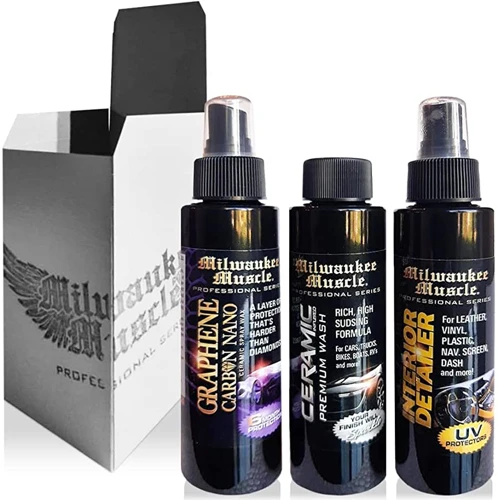
When it comes to keeping our homes clean and tidy, many of us reach for expensive cleaning products without ever realizing that we likely have several items in our own homes that can do the job just as well, if not better. In fact, some of the most effective cleaning and shining agents can be found in our pantries and closets. Today we’ll explore seven surprising household items you can buff to a shine, using everyday items like vinegar, cornstarch, and mayonnaise to revitalize everything from stainless steel to silverware. So why spend a fortune on polishes when you likely have everything you need right at home?
Why spend dollars on polishes?
It can be quite a hassle to keep your household items looking their best. Many people turn to expensive polishes to keep their appliances, cookware, and other household items looking shiny and new. However, the truth is that spending dollars on polishes isn’t necessary. There are actually several surprising household items that can be used to buff items to a shine. Not only are these alternatives more economical and natural, but they are also safe for use around children and pets. In fact, some polishes contain harsh chemicals that can be harmful if ingested or inhaled.
Why spend dollars on polishes when you can use natural alternatives? By opting for natural alternatives, you can save money, and also feel good about making eco-friendly choices. These household items are effective in cleaning and shining a variety of items around your home. The table below provides a summary of some of the natural alternatives that can be used for cleaning and polishing:
| Alternative | Household Item |
|---|---|
| Vinegar | Non-stick pans, stainless steel bowls |
| Corn Starch | Scorched iron, silver |
| Baking Soda | Pots, glass pans |
| Mayonnaise | Wood surfaces, stainless steel appliances |
| Chalk | Glassware, copper, brass |
| Aluminum Foil | Rusty silverware, chrome surfaces |
These natural alternatives are easy to find and use. They can help you to keep your household items looking clean and new without breaking the bank or using harsh chemicals. You can enjoy the many benefits of buffing your household items by using these natural alternatives. To learn more about these benefits, check out our article on the benefits of buffing household appliances.
Items you need
To make your household items shine like new, you don’t need to spend dollars on expensive polishes or cleaning products. Using natural and economical items, such as vinegar, baking soda, and mayonnaise, can be just as effective in buffing to a shine. Here are the items you need to get started:
| Vinegar | Corn Starch | Baking Soda | Mayonnaise | Chalk | Aluminum Foil |
|---|---|---|---|---|---|
| White vinegar | Corn starch | Baking soda | Mayonnaise | Chalk | Aluminum foil |
| Water | Water | ||||
| Dish soap |
These natural items are safe to use and can be found in most households. Additionally, using these items can help reduce the use of harmful chemicals and save money.
If you are new to buffing techniques, check out our Beginner’s Guide to Buffing Techniques to learn more about the process. You can also learn about the difference between buffing and polishing in our Buffing vs Polishing: What’s the Difference? article. For information on choosing the right buffing wheel for your project, take a look at our Guide to Choosing the Right Buffing Wheel.
If you encounter any mistakes or issues during the buffing process, our Troubleshooting Guide to Buffing Mistakes can help you identify and fix any problems. Finally, if you are interested in learning about the top brands for buffing and polishing products, check out our Top 5 Buffing and Polish Brands article.
Vinegar
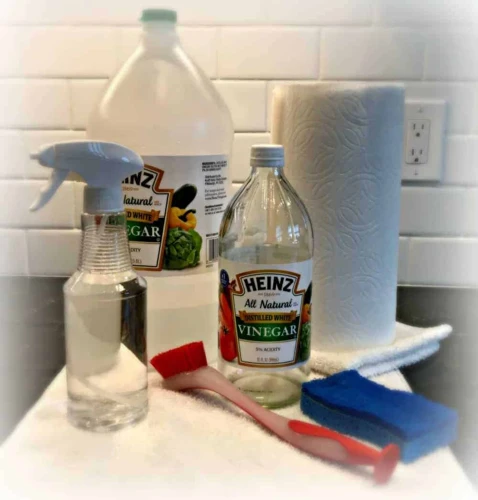
For many of us, vinegar may only be seen as an essential ingredient for cooking or dressing salads. However, this multi-purpose liquid can do much more than add flavor to your dishes. When it comes to cleaning and shining household items, vinegar can be surprisingly effective. Its acidic properties can help dissolve tough stains and grime without harsh chemicals. In this section, we will explore the surprising ways vinegar can be used to buff common household items to a shine.
How it shines non-stick pans?
Vinegar is a great household item to have on hand, not just for making salad dressings but also for cleaning! Surprisingly, vinegar can also be used to shine non-stick pans. Here’s how it works:
Step 1: Mix equal amounts of water and vinegar in a small bowl.
Step 2: Dip a soft cloth into the mixture and then use it to wipe the non-stick pan. If the pan is really dirty, you may need to let the mixture sit on the surface for a few minutes to help break down any built-up grime.
Step 3: Rinse the pan thoroughly with water and then dry it with a clean cloth. You’ll be surprised at how shiny and clean the non-stick surface looks!
Note: Avoid using abrasive sponges or cleansers on non-stick pans as these can scratch the surface and ruin the non-stick coating.
| Items Needed: | Instructions: |
|---|---|
| Water | Mix equal amounts of water and vinegar in a small bowl. |
| Vinegar | Mix equal amounts of water and vinegar in a small bowl. |
| Soft Cloth | Dip a soft cloth into the mixture and then use it to wipe the non-stick pan. |
| Water | Rinse the pan thoroughly with water and then dry it with a clean cloth. |
Using vinegar to shine non-stick pans is not only effective but also an environmentally friendly solution that is far cheaper than buying specialized cleaning products!
How it revives stainless steel bowls?
Stainless steel bowls are a staple in most kitchens due to their durability and versatility. However, over time, these bowls may lose their shine and become dull. Instead of purchasing expensive polishing agents, vinegar can be used to revive your stainless steel bowls. Here’s how:
- First, rinse the bowl with warm water to remove any dirt and debris.
- Next, pour white vinegar onto a soft cloth or paper towel.
- Use the cloth or paper towel to rub the bowl in a circular motion.
- Pay extra attention to any areas with stains or discoloration.
- Rinse the bowl with warm water to remove any vinegar residue.
- Finally, dry the bowl with a clean cloth to reveal its restored shine.
The acidic properties in vinegar are effective in breaking down any grime and restoring stainless steel to its original shine. This is a simple and natural solution that will cost less than purchasing a commercial polishing agent. So, next time you notice your stainless steel bowls looking dull, try using vinegar as a cost-effective and easy solution for a shiny and clean appearance.
Corn Starch
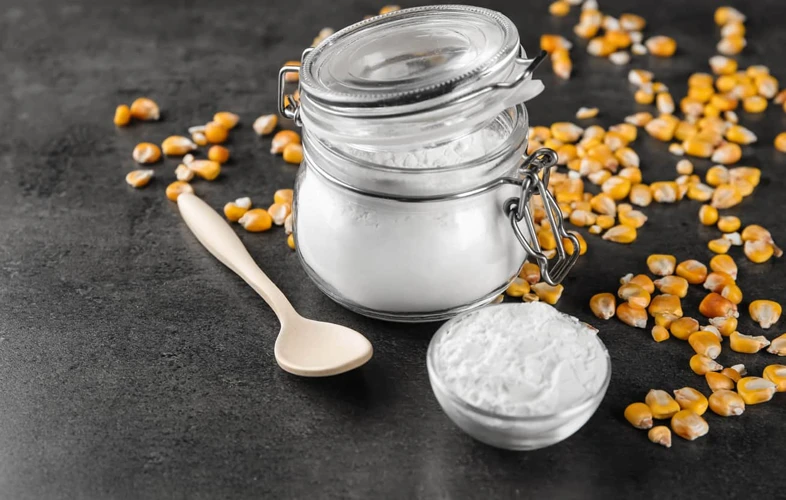
Are you feeling perplexed about the cleaning power of corn starch? Believe it or not, this kitchen staple can work wonders on some of your toughest household messes. With its abrasive texture and natural properties, corn starch can clean and polish a variety of surfaces. Keep reading to discover how this unsung hero can help you tackle everything from scorched irons to tarnished silver.
How it cleans a scorched iron?
Corn starch is a natural cleaning agent that can be used to tackle stubborn stains on various surfaces. One of its surprising uses is for cleaning a scorched iron. If you have accidentally left the iron on high heat for too long, it may develop unsightly brown stains that can transfer onto your clothes. However, don’t worry, as corn starch can quickly eliminate these stains and bring your iron back to its former glory. Here’s how:
Steps:
| Step 1: | Begin by heating your iron on low heat to warm it up. Switch off and unplug the iron once it’s warm enough. |
| Step 2: | Sprinkle some corn starch onto a clean piece of cloth. |
| Step 3: | Gently rub the cloth over the scorched area on the iron. Be extra careful while cleaning the soleplate. |
| Step 4: | Use a damp cloth to wipe off the corn starch residue and stains. |
| Step 5: | Fill the iron’s water compartment with equal parts of white vinegar and water. |
| Step 6: | Heat the iron and let it steam for a few minutes. Once done, unplug the iron and allow it to cool down. |
| Step 7: | Empty the water compartment and rinse the soleplate with a damp cloth. |
By following these simple steps, you can easily remove tough stains from your scorched iron and make it look like new again. The natural cleaning properties of corn starch and white vinegar make this cleaning method safe and economical. So, the next time you accidentally scorch your iron, don’t panic, grab some corn starch and get cleaning!
How it polishes silver?
When it comes to polishing silver, the solution might be found in a common household item – corn starch. Corn starch is an effective, yet gentle abrasive that can bring back the shine to your silverware. Here’s how to use it:
| Items you need: | Steps to follow: |
|---|---|
|
|
Using corn starch to polish your silver is not only effective, but it’s also a safe and natural alternative to harsh chemicals. Plus, you probably already have corn starch in your pantry, making this cleaning solution both economical and eco-friendly. Don’t let tarnished silverware ruin your next dinner party – give corn starch a try and bring back the shine!
Baking Soda
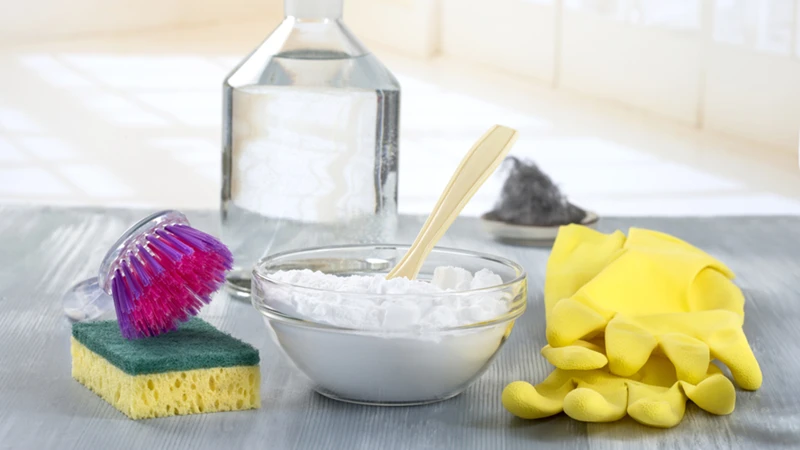
Among the many household items that can be used for various cleaning and shining purposes, one that might surprise you is a white, powdery substance often found in the kitchen pantry. Known for its usefulness in baking and cooking, this versatile substance can also be used as an effective cleaner and polisher. Using a few simple steps and some everyday items, you can use this household item to buff and shine everything from pots and pans to glassware and baking dishes. So, if you’re looking for a natural and economical alternative to traditional cleaners and polishes, let’s explore the surprising ways in which this pantry staple can be used to buff household items to a shine.
How it buffs pots?
Baking soda has many cleaning properties, including buffing and shining pots. To buff pots with baking soda, you will need the following items:
| Items | Quantity |
| Baking soda | 1/2 cup |
| Water | 3 tablespoons |
| Clean cloth | 1 |
First, mix the baking soda and water to form a paste. Then, apply the paste to the pot with a clean cloth. Use circular motions to buff the pot with the paste. Rinse the pot thoroughly with water and dry it with a clean cloth. The baking soda paste will leave the pot shiny and clean.
It is important to note that this method may not work on pots with deep scratches or stains. In those cases, a more specialized pot cleaner may be necessary. However, for everyday cleaning and buffing of pots, baking soda is a natural and effective option.
How it cleans burnt crusts from glass pans?
Glass pans are notorious for developing burnt crusts that are hard to remove. However, baking soda can effectively remove the burnt crusts from glass pans. Here’s how you can do it:
- Place the glass pan in the sink
- Sprinkle a generous amount of baking soda on the burnt crusts
- Pour boiling water over the baking soda and burnt crusts
- Let it sit for at least an hour
- After an hour, use a soft sponge to scrub the bottom of the pan
- Rinse the glass pan with warm water and dry it with a clean towel
The combination of baking soda and boiling water helps to lift and dissolve the burnt crusts, making it easy to scrub them off. This method is also gentle on glass pans and won’t scratch or damage them. So, if you have a glass pan with stubborn burnt crusts, try using baking soda to clean it instead of harsh chemical cleaners.
Mayonnaise
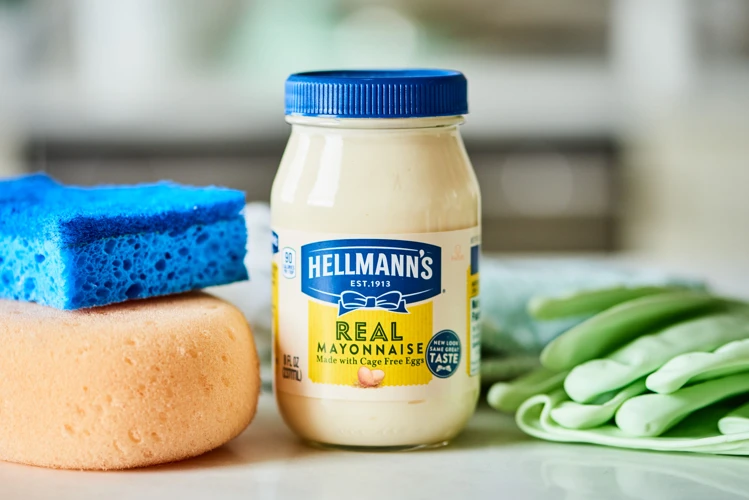
You might not expect to find this condiment in your cleaning arsenal, but it turns out that mayonnaise can be a surprisingly effective cleaning agent! Believe it or not, this tangy spread can polish wood surfaces and make stainless steel appliances gleam. So, if you have a jar of mayonnaise sitting in your fridge, don’t just use it for sandwiches – grab it to give your household items a shine. Let’s see how it works.
How it polishes wood surfaces?
Mayonnaise is a versatile household item which can also be used for polishing wood surfaces. It is a safe and natural alternative to traditional wood polishes that may contain harsh chemicals. The oils in mayonnaise help to nourish and moisturize the wood, leaving it looking shiny and like new.
To use mayonnaise for polishing wood surfaces, follow these simple steps:
- Clean the surface: Before polishing the wood, make sure it is clean and free of any dust or debris. Use a clean cloth to wipe away any dirt or grime from the surface.
- Apply the mayonnaise: Take a spoonful of mayonnaise and apply it to the wood surface. Use a clean cloth to rub the mayonnaise into the surface, making sure to cover the entire area evenly.
- Let it sit: Allow the mayonnaise to sit on the wood surface for a few minutes. This will give the oils time to penetrate and nourish the wood.
- Wipe away excess: Use a clean cloth to wipe away any excess mayonnaise from the surface. Be sure to remove all of the mayonnaise to avoid leaving any residue on the wood.
- Buff the surface: Use a clean, dry cloth to buff the wood surface until it shines. This will help to remove any remaining residue and bring out the natural shine of the wood.
Using mayonnaise to polish wood surfaces is a simple, easy and economical way to keep wooden furniture, floors, and accessories looking great. Give this technique a try and see the difference it can make to the appearance of your wood.
How it makes stainless steel appliances shine?
Mayonnaise isn’t just a delicious condiment for sandwiches, it can also be used as a natural polish for stainless steel appliances. With its acidic properties and oily consistency, mayonnaise can help remove stubborn stains and restore shine to stainless steel surfaces. Here’s how to use it:
- Clean the surface: Before using mayonnaise, you should clean the stainless steel surface with soap and water to remove any dirt or grime
- Apply a small amount of mayonnaise: Use a soft cloth or sponge to apply a small amount of mayonnaise to the surface. Rub it in gently with circular motions.
- Let it sit: Leave the mayonnaise to sit on the surface for a few minutes, allowing it to penetrate and break down any tough stains or grime.
- Wipe off the excess: After the mayonnaise has had time to work, take a clean cloth or sponge and wipe away the excess. Make sure to remove all of the mayonnaise to avoid leaving any residue on the surface.
- Buff to a shine: Finally, take a clean, dry cloth and buff the surface to a shine. Your stainless steel appliances should now look brand new!
By using mayonnaise as a natural polish, you can avoid using harsh chemicals that can be harmful to your health and the environment. Plus, you’ll save money by using a household item you probably already have in your fridge. Give it a try and see the surprising results for yourself!
Chalk
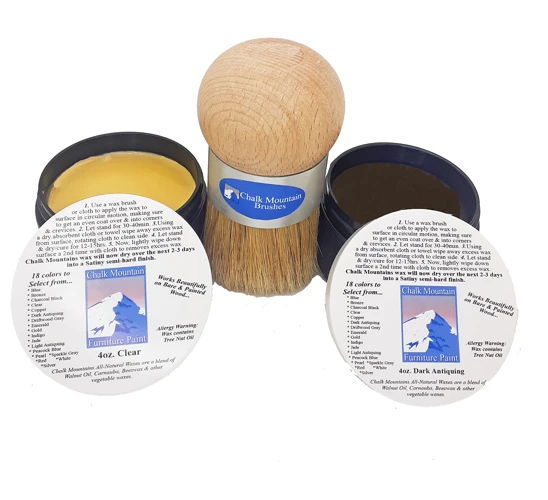
Are you tired of chalky residue on your glassware? Do you have copper or brass in need of polishing? Luckily, there’s a surprising household item that can help with both tasks: chalk! Yes, the same chalk you might use on a chalkboard has a variety of cleaning and polishing uses throughout your home. With its gentle yet effective abrasive properties, chalk can tackle tough stains and leave your surfaces shining like new. Let’s take a closer look at how you can use this household item to clean and polish your home.
How it cleans chalky residue from glassware?
Glassware can often become cloudy or chalky over time, especially if it’s frequently washed in the dishwasher. This can be a frustrating problem, but there’s a simple solution that you may already have in your pantry: chalk.
To clean chalky residue from glassware, start by crushing a few pieces of white chalk into a fine powder. Then, fill the affected glasses or dishes with warm water and stir in the chalk powder until it forms a paste. Let the mixture sit for a few minutes, and then scrub gently with a soft-bristled brush or cloth. Rinse the glassware thoroughly with warm water and dry with a soft, clean towel.
Here’s a table summarizing the steps:
| Materials | Steps |
|---|---|
| White chalk | 1. Crush chalk into a powder. |
| Glassware with chalky residue | 2. Fill with warm water. |
| 3. Stir in chalk powder to form a paste. | |
| 4. Let sit for a few minutes. | |
| Soft-bristled brush or cloth | 5. Gently scrub the inside of the glassware. |
| 6. Rinse thoroughly with warm water. | |
| Soft, clean towel | 7. Dry the glassware. |
Chalk is a gentle abrasive that helps to break down the buildup of minerals and other deposits that can cause your glassware to look cloudy. This method is safe for most types of glass and is a natural and economical alternative to chemical cleaners. Plus, using chalk to clean your glassware means you’ll have one less item to worry about when doing your grocery shopping.
How it polishes copper and brass?
Chalk can surprisingly polish copper and brass items in your household! Here’s how:
- Take a stick of white chalk and grind it into a fine powder.
- Add a few drops of water to make a paste.
- Dip a soft cloth into the paste and gently rub it onto the surface of the copper or brass item.
- Rub the affected area for a few minutes until it shines.
- Wipe off any excess paste with a clean, damp cloth.
- Finally, buff the item with a dry cloth for a brilliant shine.
The mild abrasive properties of chalk help remove any tarnish, stains or discoloration from the copper or brass surface without causing any scratches or damage. Plus, the chalk coating on the surface also helps prevent future tarnishing, keeping your brass or copper utensils looking brand new. Whether it’s your antique tea set, metal jewelry or home accents, this natural polishing method with chalk can effectively restore the shine to your copper and brass items.
Aluminum Foil
When it comes to keeping our household items shiny and clean, we often rely on expensive polishes and cleaners. However, what if we told you that the solution to your cleaning woes lies in one simple, affordable item that you have in your kitchen? That’s right, we’re talking about aluminum foil. This unassuming household item is not only great for wrapping leftovers, but it can also be used to restore the shine to a variety of surfaces around your home. Read on to learn about the surprising ways that aluminum foil can be used to buff your household items to a sparkling finish.
How it cleans rusty silverware?
If you have rusty silverware at home, don’t worry, you don’t have to buy expensive cleaners. You can easily remove rust and make them shine again with a few simple steps using aluminum foil.
Materials you need:
| Materials | Instructions |
|---|---|
| Aluminum Foil | Take a piece of aluminum foil that is large enough to cover the bottom of your sink. |
| Hot Water | Fill your sink with hot water enough to cover the silverware. |
| Baking Soda | Add a tablespoon of baking soda to the water and stir it well. |
| Silverware | Place your rusty silverware in the sink and let them soak for 15-20 minutes. |
| Scrub Sponge | Afterward, use a scrub sponge to gently rub away the rust from the silverware. |
| Clean Water | Rinse the silverware with clean water and dry them with a soft cloth. |
Using aluminum foil is a simple and effective method to remove rust from silverware without using any harmful chemicals. Plus, it’s much more economical than buying expensive silver cleaners. The baking soda also helps to enhance the cleaning process, leaving your silverware looking shiny and new again. Try this natural cleaning hack next time and see how well it works for you!
How it buffs chrome surfaces?
To buff chrome surfaces at home, you can use aluminum foil! Here’s how:
- Cut a piece of aluminum foil that is large enough to cover the entire chrome surface that needs to be polished.
- Dip the foil into some water and then use it to gently rub the chrome surface.
- Continue rubbing with the foil until you start to see the shine return to the chrome.
- Use a clean cloth to wipe away any residue from the aluminum foil and polish the surface.
The abrasive nature of the aluminum foil helps to remove any built-up dirt or grime on the chrome surface, leaving it shiny and polished. This method is a great natural alternative to chemical-based chrome polishes, and it can save you money too!
Conclusion
As we conclude our article exploring surprising household items that can be used to buff household items to a shine, it is clear that there are many natural and safe alternatives to expensive polishes. By using common items found in most homes, you can save money and minimize the use of potentially harmful chemicals. From vinegar and baking soda to mayonnaise and chalk, these household items have proven to be, time and time again, effective cleaners and polishes that can help breathe new life into your tarnished and dull household items. So why spend dollars on polishes when you can achieve the same effect with natural, safe and economical alternatives?
Choose Natural, Safe and Economical Alternatives to Clean and Shine your Home!
When it comes to cleaning and shining household items, there’s no need to spend a fortune on expensive polishes and cleaners, when you can use natural, safe and economical alternatives. Not only are these alternative cleaning solutions budget-friendly, but they are also less harmful to your health and the environment. Here are some reasons why you might want to choose natural and safe cleaning alternatives:
- Budget-friendly: Natural cleaning solutions such as vinegar, baking soda, and corn starch are affordable compared to specialty cleaning products. You can save some money by using what’s already in your pantry shelves to clean and shine household items.
- Less harmful: Household cleaning products can contain harsh chemicals that might be harmful to your health and the environment. Using natural cleaning alternatives can help reduce the use of these hazardous chemicals in your home, making it safer for you, your family, and the planet.
- Versatile: Most natural cleaning solutions have multiple uses, making them a cost-effective and versatile option. For instance, vinegar can be used to clean windows, remove odors, and as a fabric softener, among other uses. Similarly, baking soda can remove stains, neutralize odors, and brighten laundry.
- Effective: Natural cleaning solutions might not have the same cleaning power as some of the commercial grade cleaners, but many of them are surprisingly effective. For instance, baking soda can effectively remove built-up grime on pots and pans, while vinegar can remove hard water stains.
- Easy to use: Most natural cleaning solutions require no special equipment or expertise to use. All you need is basic knowledge of their uses and some elbow grease. Natural cleaning solutions are easy to use and save you time and hassle.
Choosing natural, safe, and economical alternatives can help you achieve a clean and shiny home without breaking the bank. The benefits of these alternatives extend beyond the cost savings as they are less harmful, versatile, effective, and easy to use. Give them a try and see how they can transform your cleaning and shining routines!
Frequently Asked Questions
Can I use apple cider vinegar instead of white vinegar to shine non-stick pans?
Yes, apple cider vinegar can also shine non-stick pans, but make sure to dilute it with equal parts of water to avoid any potential damage to the coating on the pan.
What type of corn starch should I use to clean a scorched iron?
Any kind of corn starch should work effectively in removing scorched marks from an iron.
How often should I buff my copper and brass items with chalk?
It depends on the usage and the level of tarnish on the items. Buffing with chalk once every three months should be sufficient for moderate usage.
What kind of aluminum foil should I use to clean rusty silverware?
Plain aluminum foil works best in cleaning rusty silverware. Make sure to use a clean and dry piece of foil for best results.
Can mayonnaise be used to clean leather surfaces?
No, mayonnaise should not be used on leather surfaces, as it may cause damage to the material. It is best to use a leather cleaner specifically designed for that purpose.
How long should I leave baking soda on burnt crusts in glass pans?
Leave the baking soda on the burnt crusts for at least an hour to effectively loosen the debris, then scrub and rinse with warm water.
Can chalk be used to clean granite countertops?
No, using chalk on granite countertops may scratch the surface. It is best to stick to a granite-specific cleaner.
How can aluminum foil be used to buff chrome surfaces?
Crumple up a small piece of aluminum foil and use it to gently buff chrome surfaces in a circular motion until the desired shine is achieved.
Can baking soda be used to clean stainless steel appliances?
Yes, baking soda can help remove stains and buildup on stainless steel appliances. Mix a paste of baking soda and water, apply to the appliance, and wipe with a clean cloth.
Is vinegar safe to use on all surfaces?
No, vinegar should not be used on all surfaces, as it may cause damage to certain materials, such as marble or granite. It is best to do a spot test before using vinegar on any surface.
